Toward the end of World War II, Hitler and his generals were anxiously waiting for the “miracle weapons” to turn the tide of war in their favor. There were two new weapons that the Nazis had developed which ultimately proved ineffective: a jet fighter and the electro-U-boat. How close did they come to using them against the enemy? More than one thousand jet planes, the Messerschmitt Me 262, were produced and put into action by mid-1944. The Allied fighter planes were no match for the Me 262 in the air. However, very few of the jets ever left the ground. German oil refineries were destroyed thereby limiting the availability of jet fuel. Second, runways had to be extended to accommodate the jets. When they saw the altered runways, Allied bomber and attack plane pilots knew the jets were parked nearby and went out of their way to target them. So, most of the Me 262s were destroyed on the ground and the jets never had any significant impact on the course of the war. Grand Admiral Karl Dönitz (1891−1980) promised Hitler that 126 new electro-U-boats would be put out to sea to once again wreak havoc on British/American shipping lanes. Only two were ever launched and like the jet, never lived up to expectations.

The third “miracle weapon” and the one that worried Roosevelt and Churchill the most was the development of the German atomic bomb. After Frédéric and Irène Joliot-Curie wrote that atomic fission was possible and could be used to develop a powerful weapon, Hitler decided to begin his atomic weapons program in 1939. It needed two very important components to be successful: uranium and heavy water. The problem for the Nazis turned out to be heavy water was very scarce and hard to produce. That problem was soon solved after Germany invaded Norway on 9 April 1940. The Vemork Norsk Hydro plant near Rjukan, Norway was capable of producing heavy water.

Did You Know?
Did you know that on 17 September 1793 the charter of the Terror⏤the Law of Suspects⏤was enacted during the French Revolution? This new decree gave the Committee of Public Safety in Paris the right to arrest and punish anyone “suspected” of treason or hoarding. In other words, an accusation was enough to send someone to the guillotine. Legal process was not followed as “oversite” committees passed judgement on one’s fate. If you didn’t like your neighbor, accuse them of hoarding bread⏤off with their head! If you thought the wine merchant overcharged you, accuse them of being a “bad citizen”⏤off with their head! Want to get rid of your spouse, accuse them of not being committed to the revolution⏤off with their head! Click here to read the blog The Law of Suspects.
A well-known American talk show co-host was recently accused of giving “validation” to “racist” views with respect to supporting another talk show host’s comment about a certain member of the royal family. (The British talk show host didn’t believe some of her statements during an interview with Oprah Winfrey.) When the accuser was asked to specifically identify the specific racist words used by the British television personality, the accuser responded by saying “It is not the exact words of racism, it’s the implication and the reaction to it.” So, the well-known American talk show co-host was fired, and her accuser (the other co-host) is still employed.
I accuse you of being a racist⏤off with your head! I accuse you of being misogynous⏤off with your head! I accuse you of disrespecting my favorite talk show⏤off with your head! It seems the court of social opinion has taken the place of the revolutionary “oversite” committee.
Keep in mind this dangerous decree from the past as you read contemporary headlines and stories in your news sources. Also, remember that the enactment of the “Law of Suspects” was the beginning of the Reign of Terror.
History does repeat itself.
Heavy Water
What is heavy water and why is it important in building an atomic bomb? Unlike normal water (H20), heavy water’s two hydrogen atoms are heavier because they have a neutron and a proton in each nucleus whereas a regular water hydrogen atom contains only one proton in its nucleus. Heavy water is used in nuclear reactors to enrich uranium (U-235) or convert to plutonium (pu-239)⏤it enables control over the fission process. In other words, heavy water plays the role in breeding weapons-grade plutonium from common uranium. In today’s world, the International Atomic Energy Agency and national governments monitor the production and distribution of heavy water.
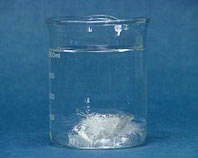

Please remember I flunked chemistry and physics. So, this is about as technical as I can get. But then again, I flunked English and here I am writing books.
The Norsk Hydro Heavy Water Plant
In 1934, Norsk Hydro (a Norwegian energy company) built a heavy water production plant in Vemork, Norway near the town of Rjukan. Once in operation, the plant could produce almost nine pounds of heavy water per day. It was the only facility in Europe capable of producing heavy water. Before the German invasion, the Norwegian government sold its stock of heavy water to France upon learning of its potential use in weapons development. (The Germans were trying to purchase it as well.) The water was then smuggled out of France and sent to England.
After the German army marched into Norway, immediate pressure was put on Norsk Hydro to increase its output of heavy water to three hundred pounds per day. (The German industrial conglomerate, I.G. Farben owned stock in Norsk Hydro.) By 1942, output had been increased to 10,000 pounds. British intelligence warned Churchill in the autumn of 1942 that Germany had stockpiled one and a half tons of heavy water and it was all stored at Norsk Hydro. Churchill learned that at five tons, the Nazis could begin production of the atomic bomb.
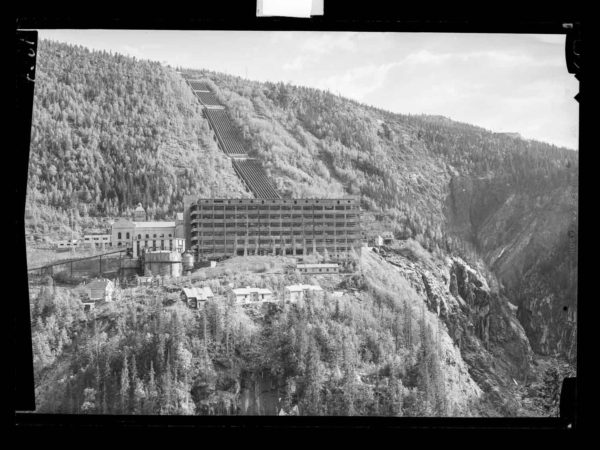
The Allied countries (in particular, England) considered the production of heavy water by the Germans to be so serious that destroying the Norsk Hydro plant was given the highest priority and substantial resources and efforts were devoted to that end. In the end, five separate commando, sea, and air attacks were devised and carried out between October 1942 and March 1944. The missions were all the same: destroy the production facility and the stockpile of heavy water.
Grouse and Freshman
British-led Special Operations Executive (SOE) called upon its Scandinavian section (Norway subsection) in the summer 1942 to provide a four-man team to train for a parachute drop onto the Hardangervidda, a wilderness area the Germans did not occupy. Their mission⏤code-named “Grouse”⏤was to reconnoiter the area and report weather conditions and German troop placements in and around the Norsk Hydro plant. This was an advance party and the first phase of a sabotage operation that became known as Operation Freshman.
The four men landed in Norway on 18 October 1942, coincidentally, the same day Hitler issued his infamous Commando Order⏤any enemy soldier or saboteur caught was to be immediately executed whether they were in uniform or not. (Click here to read the blog Hitler’s Directives). It took more than two weeks of walking through dangerous conditions for the men to reach their destination. They had trouble with their wireless radio and could not contact London until early November. Working at four thousand feet, Grouse began to inform London of the weather conditions, troop placements, and the terrain. They also chose a suitable landing site for the gliders that were to be used in the next phase. It was determined that weather conditions including the moon phase were satisfactory to allow for the next phase to begin. All the four men had to do was wait in place for Operation Freshman to commence.
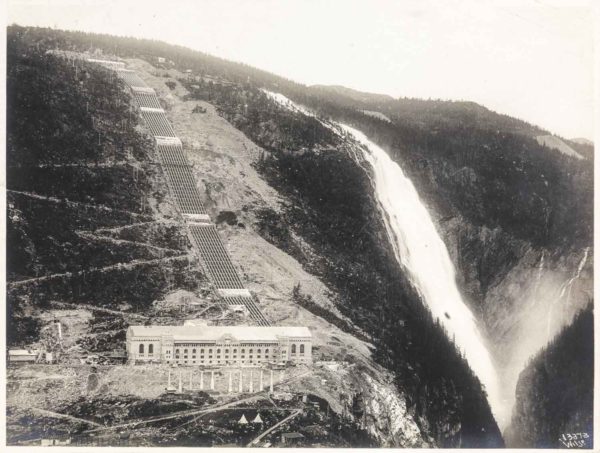
The heavy water plant was situated in a deep valley surrounded by thickly forested sides that rose almost vertically from a narrow river. The plant itself was built on a rock shelf one thousand feet above the river. The Nazi commander of Norway, Generaloberst Nikolaus von Falkenhorst (1885−1968), only had three hundred thousand men to occupy Norway and did not have the reserves necessary to fully protect the plant. By the time they dropped in, Grouse observed twelve soldiers at the plant, twelve at the dam, and forty soldiers in the town of Rjukan. They also noted that the men were older under the command of an elderly captain. There were iron hawsers strung across the valley to prevent low-level bombing runs. The ground defenses were protecting the ridge above the plant where the Germans believed any attacks would come from. On the sides of the building were minefields and booby traps. A machine gun nest was placed at the front entrance while flood lights were erected on the roof. A narrow bridge crossed the gorge below the plant and was protected by two guards. If you have seen the movie, Where Eagles Dare, you can appreciate the formidable task that the men of Operation Freshmen faced. But then again, they didn’t have Clint Eastwood and Richard Burton on their team.
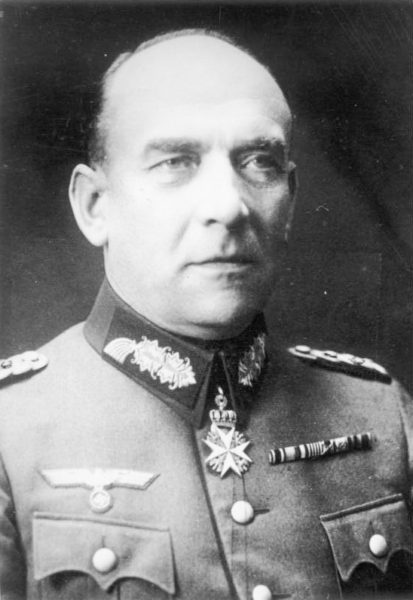
It was determined that Operation Freshman would commence on 19 November 1942 as a combined operation of the Royal Air Force (RAF) and the army. Two Halifax bombers were used to tow one Horsa glider apiece. (Each glider carried one officer, one sergeant, thirteen other ranks, and the two pilots.) Their mission was to destroy existing stocks of heavy water and collect samples of the water. The glider landing site was three miles away. Grouse was responsible for marking the strip once the Halifax planes were in sight. Orders to the men included no excuses for halting the mission. If a man was wounded, give him morphine and keep moving. If a man fell out, leave him.
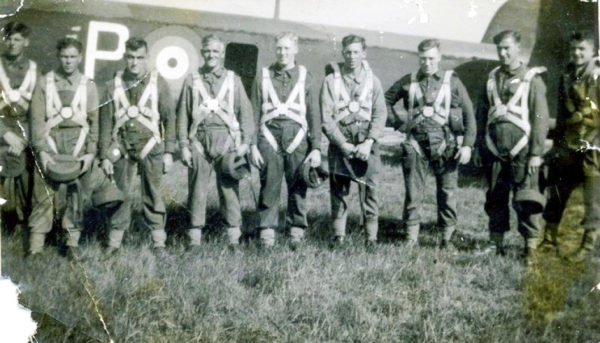
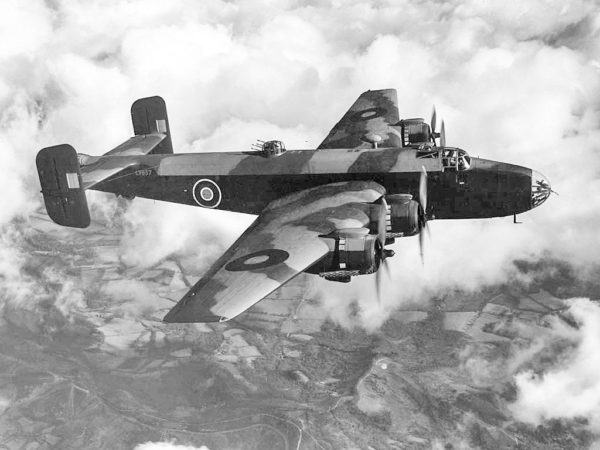
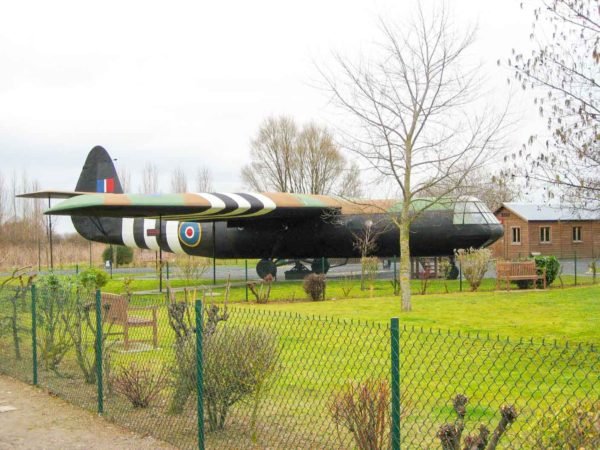
As the planes reached Norway, the weather turned. The pilots were unable to locate the target. It is suspected that one of the planes and its glider flew too low and crashed into the side of a mountain. The other Halifax turned around because its fuel level was dangerously low. After crossing the coastline, the tow line began icing and the pilot released the glider. The glider pilots were able to turn back toward land and crash landed near where the first glider had gone down. On 21 November, the Germans announced that two British bombers flew into southern Norway and crashed. All of the survivors were captured. Under the orders of Falkenhorst (i.e., Hitler’s commando directive), every man was executed. Some were shot, two were killed by injections of morphine, water, and air, and others were tied to boulders and thrown into the fjord. A memorial stone was later erected in Stavangar, Norway to honor the men. Twenty-five of the men are buried at the Eiganes cemetery in Stavangar.
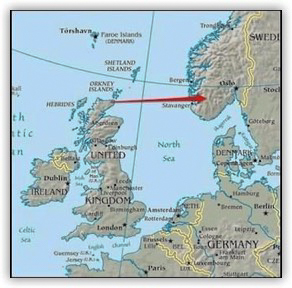
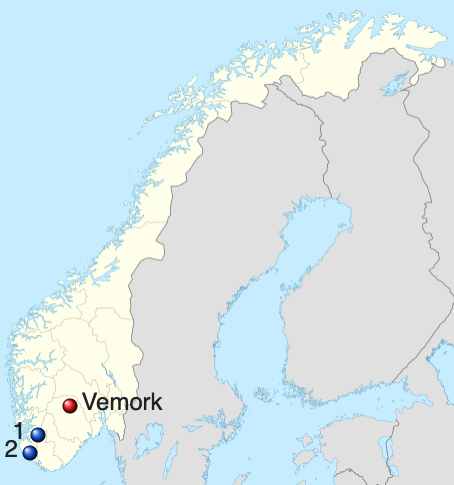
The failure of Operation Freshman was quite a blow to British military command as well as the four men of Grouse, all of whom remained in place waiting for the next commando operation (their team was renamed “Swallow”). London wired them, “Keep up your hearts. We will do the job yet.” Details of Operation Freshman were kept secret for more than thirty years by the British government.
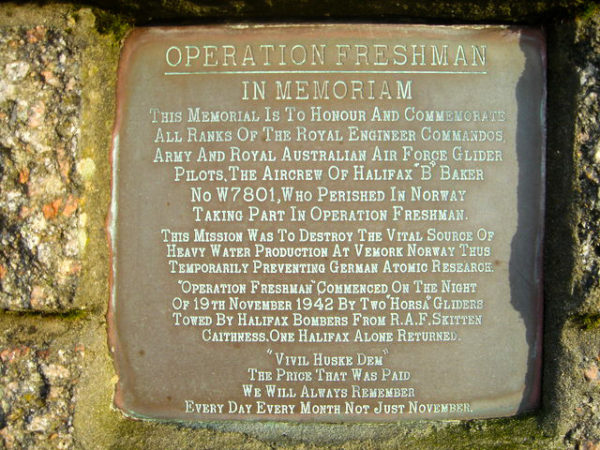
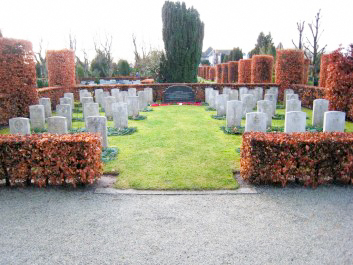
Operation Gunnerside
Swallow did not have to wait long. By February 1943, SOE had come up with a new plan⏤Operation Gunnerside. The target and objectives remained the same. The British had learned some lessons from the previous operation including using only Norwegian agents. This time, only six men were picked: Lt. Joachim Rønneberg (1919−2018) was the leader along with Knut Haukelid (1911−1994), Kasper Idland, Hans Storhaug, Frederik Kayser, and Birgr Stromsheim filling out the team.
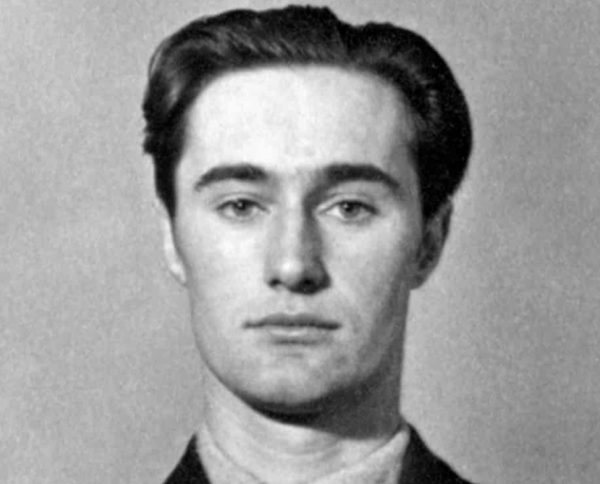
On 16 February, the men were dropped by parachute at the target site of Bjornesfjorden, only about nineteen miles from Swallow’s camp. The weather began to quickly deteriorate, and they found refuge in a hut. By 23 February, Swallow met up with the six men at the hut. Two days later, Swallow and Gunnerside left the hut to begin their advance toward the Norsk Hydro plant (alternately walking and skiing).
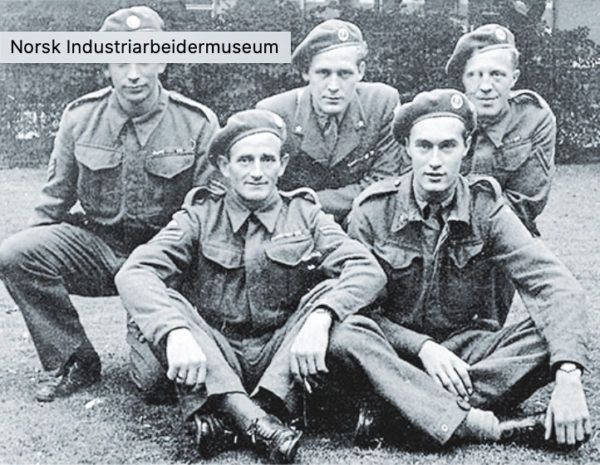
On the night of 27/28 February, the men attacked the plant. Divided into two groups, one set neutralized the German security guards while the second group planted the explosives in the underground basement (it was considered to be bomb-proof) where the production facilities including water storage were located. They set the fuses to detonate within 30-seconds. All of the men escaped to witness the destruction. The ten men reached the plateau where they split up. One group of five skied their way to Sweden and eventually got back to England. The other five stayed put and continued transmitting information to London.
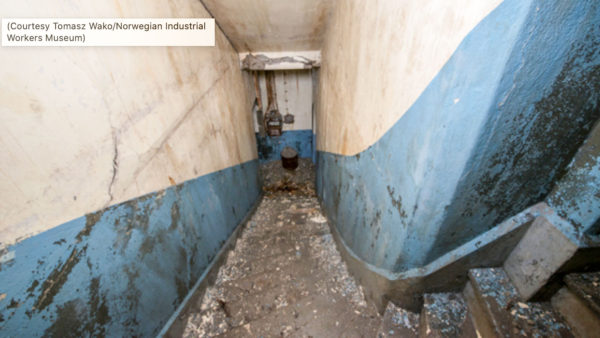
Equipment used to manufacture heavy water was rendered useless and they estimated that more than eleven hundred pounds of heavy water was blown up. London believed the plant was out of business for the next twelve months. Unfortunately, London was wrong. The facility was producing heavy water by August 1943.
Now, London had to make a decision. They couldn’t allow the production of heavy water to continue but felt that another commando operation was too risky. (The Nazis increased security in and around the plant.) So, the decision was made to undertake a difficult bombing run.
United States Army Air Force
It was agreed the USAAF would begin a series of raids on the plant once production started back up. In November 1943, one hundred forty-three B-17 bombers hit the plant in a day-light bombing run. Only sixteen percent of the bombs hit the target. A second and third run were ordered for 16 and 18 November. These two missions using B-24s were successful. While the plant survived, the bombing raids convinced the Germans to abandon the facility and transfer the existing heavy water stock to Germany.
The SF Hydro
Knut Haukelid stayed behind in Norway after the completion of Operation Gunnerside. London informed him that the Germans were planning to move the heavy water back to Germany. His orders were to destroy the shipment. Haukelid recruited several trustworthy Norwegian resistance fighters to assist him.
They learned that railcars carrying drums of heavy water were to be loaded onto a railway ferry, the SF Hydro, and take its cargo across Lake Tinn. One of Haukelid’s team knew a crew member on the ferry. He gained access to the interior of the ship and planted his bomb. As the ferry reached deep water on 20 February 1944, the bomb went off and the ferry sank. Eighteen people were killed while twenty-nine survived. Drums of water floated on the surface leading to the speculation that heavy water was not in them (otherwise they would have sunk). It was later determined that many of the drums were only half full. Almost sixty years after the incident, one of the drums was analyzed and it was determined the concentration of heavy water was very small.
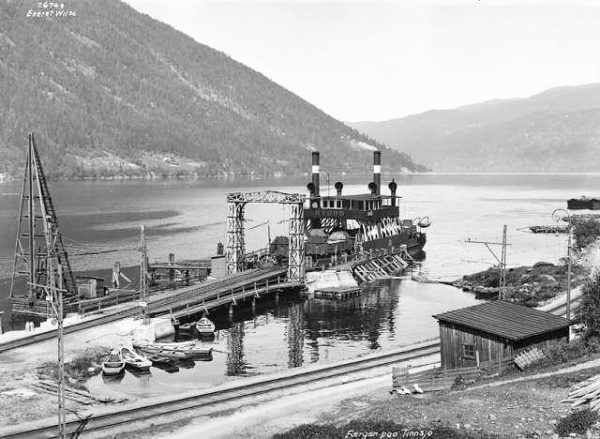
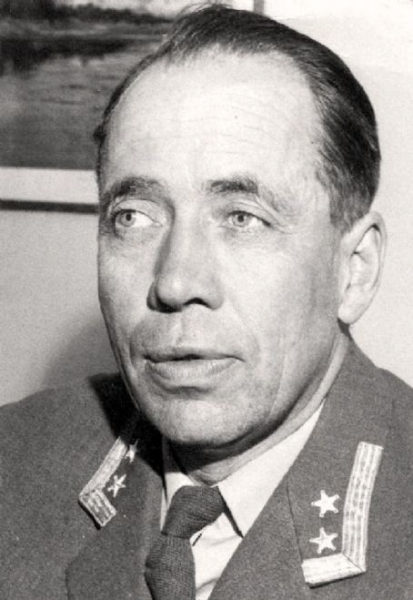
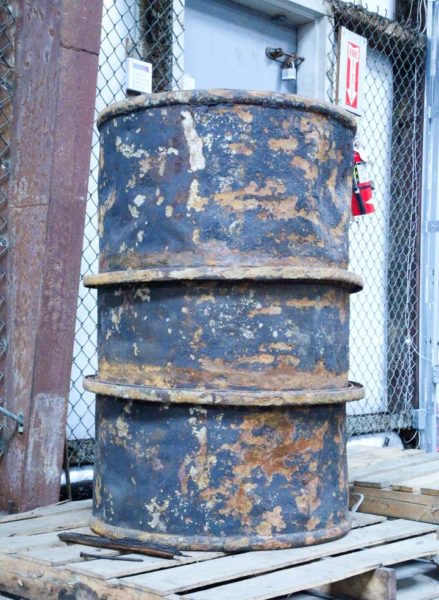
Aftermath
The Americans had begun their own nuclear bomb development program in 1939. It was known as the Manhattan Project. Following the September 1943 Allied invasion of Italy, the Americans became concerned about German advancements in developing the atomic bomb. Brig. Gen. Leslie Groves was assigned the responsibility of creating a team to determine enemy scientific developments, including the bomb. The mission was called Alsos. This was a sophisticated, complicated, and wide-ranging mission of gathering intelligence including the capture (and potential assassination) of key German scientists (Click here to read about Moe Berg, baseball player turned spy.) In the end, it was determined the Germans were only able to muster up a very small amount of uranium and their laboratories were insufficient to handle the research necessary to make the bomb. Using the information from the Alsos mission along with the results from Operation Gunnerside concerning heavy water, the Allies came to the final conclusion that the Axis powers were nowhere near to completing the development of an atomic bomb.
The men involved these in missions are now deceased. The last of them, Joachim Rønneberg, passed away in 2018 at the age of ninety-nine. Most of the men received awards and honors from many countries for their wartime services. Fortunately, we have their stories from first-hand accounts.
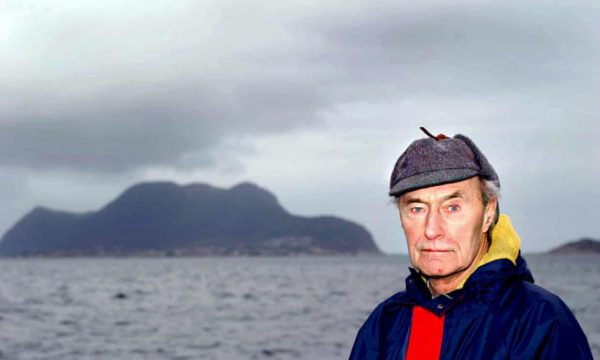
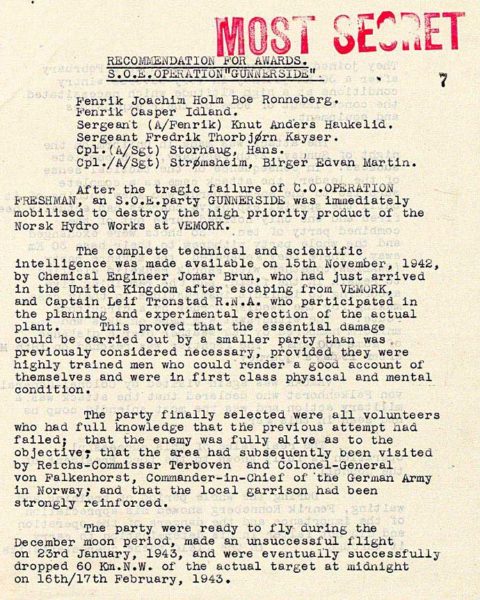
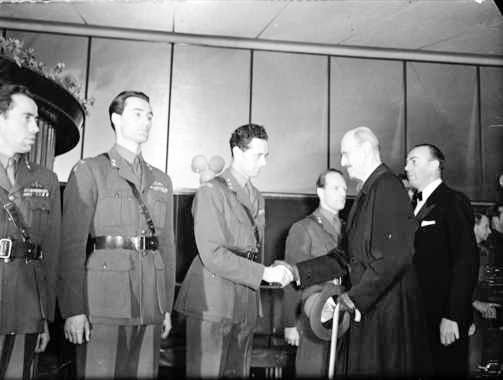
Click here to watch the video clip Joachim Ronneberg: Rest in Power.
Many of the Nazis who signed and carried out the orders to execute the men captured as part of Operation Freshman were convicted after the war and shot. Falkenhorst was found guilty and sentenced to death but it was commuted to twenty years in prison. He was released in 1953. (Almost all imprisoned former Nazis were released by 1956.)
The building that once produced the heavy water was demolished in 1977. Archaeologists from the Telemark County Council began a project to excavate the nearly 15,000 cubic feet of rubble that was thirty feet deep and sitting on top of the former plant. Removing the rock, the archaeologists found the underground rooms where the heavy water was produced.
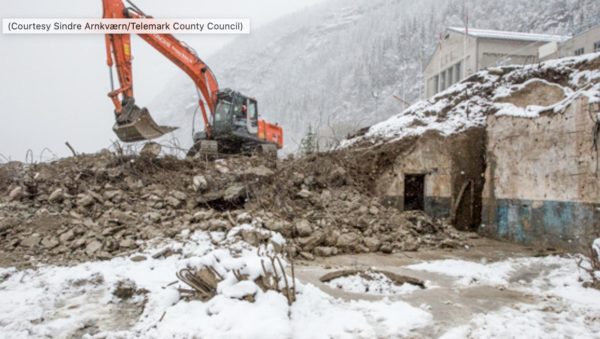
★ ★ ★ Learn More About Heavy Water and its Destruction ★ ★ ★
Berglyd, Jostein. Operation Freshman: The Hunt for Hitler’s Heavy Water. Hägersten, Sweden: Leandoer and Ekholm (now Leandoer Forlag), 2008.
Fisz, Benjamin (producer). The Heroes of Telemark. Benton Film Productions, 1965.
Goudsmit, Samuel A. Alsos. New York: Henry Schuman, 1947.
Insall, Tony. Secret Alliances: Special Operations and Intelligence in Norway 1940−1945. Hull, England: Biteback Publishing, 2020.
Milton, Giles. Churchill’s Ministry of Ungentlemanly Warfare: The Mavericks Who Plotted Hitler’s Defeat. New York: Picador (imprint of Macmillan Publishing Group), 2016.
Pash, Boris. The Alsos Mission. New York: Charter Books, 1969. Shirer, William L. The Rise and Fall of the Third Reich. New York: Simon and Schuster, 1960 (page 1099).
Disclaimer:
There may be a chance that after we publish this particular blog, the video links associated with the blog are no longer accessible. We have no control over this. Many times, whoever posts the video has done so without the consent of the video’s owner. In some cases, it is likely that the content is deemed unsuitable by YouTube. We apologize if you have tried to access the link and you don’t get the expected results.
What’s New With Sandy and Stew?
We have begun to edit Roy’s book comps for Where Did They Put the Gestapo Headquarters? A Walking Tour of Nazi-Occupied Paris. We are hoping to have a completed galley to review in four weeks. At that point, we will be very close to having the book printed.
If you would like to purchase a personalized and autographed copy of the book, please contact me at stew.ross@yooperpublications.com and I’ll reserve a copy for you. Books purchased through Amazon are not autographed.
Thanks to all of you who subscribe to our bi-weekly blogs. It seems there isn’t a day that goes by where we don’t increase our readership. Please let your history buff friends and family members know about our blog site and blogs.
Someone Is Commenting On Our Blogs
I’d like to thank Steve Snyder for his kind comment regarding our recent blog, Escape Lines (Click here to read the blog.) Steve is the author of Shot Down: The True Story of Pilot Howard Snyder and the Crew of the B-17 “Susan Ruth”. It’s a fascinating story and will give you the background of the B-17 and air campaign conducted by the United States Army Air Force. His father’s story is uplifting and you won’t be disappointed. If there is a topic you’d like to see a blog written about, please don’t hesitate to contact me. I love hearing from you so keep those comments coming.
Why Would You Want to Buy Our Walking Through History Books?
Simple.
You like to travel and experience history and historical events. You like to see original buildings that had a significant impact on the people and events of the history you’re engaged with. You want to know the stories behind the brick and mortar in front of you.
The walking tour books are meticulously researched so you can go directly to those sites and learn about the building’s history as well as an introduction to some of the more interesting people associated with it.
We Need Your Help
Please tell your friends about our blog site and encourage them to visit and subscribe. Sandy and I are trying to increase our audience and we need your help through your friends and social media followers.
Thank You
Sandy and I appreciate you visiting with us. We have some exciting things on the horizon, and we’ll keep you updated as we go along.
Share This:
Follow Stew:
Find Stew’s books on Amazon and iBooks.
Please note that we do not and will not take compensation from individuals or companies mentioned or promoted in the blogs.
 Walks Through History
Walks Through History
Copyright © 2021 Stew Ross
